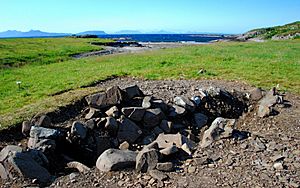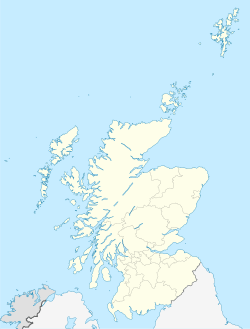Port an Eilean Mhòir boat burial facts for kids

The Port an Eilean Mhòir boat burial site
|
|
| Location | Highland, Scotland |
|---|---|
| Coordinates | 56°45′36″N 6°1′12″W / 56.76000°N 6.02000°W |
The Port an Eilean Mhòir ship burial is a special Viking boat burial site. It is located in Ardnamurchan, Scotland. This spot is the most western point on the island of Great Britain.
Archaeologists found this burial site in 2011. It dates back to the 10th century, which is over 1,000 years ago. The burial holds the remains of a man. He was laid to rest inside a Viking boat. The boat was about 5 meters (16 feet) long and 1.5 meters (5 feet) wide.
The man was buried with many items. These items are called grave goods. They included his shield, sword, and spear. Other items were also found with him.
Before this discovery, other possible ship burials were found in Scotland. In 1924, some nails and rivets were found at Cul na Croise in Ardnamurchan. People thought they came from a ship burial. However, the exact spot is now lost. Another site was found in 1935 at Huna. This one was better recorded and is known as a ship burial. Nine other Viking boat burials have been found on Scottish islands. Six of these are in the Hebrides and three in the Northern Isles.
Archaeologists from the Ardnamurchan Transitions Project announced the discovery. This project is run by the Universities of Manchester and Leicester. CFA Archaeology and Archaeology Scotland also helped. For many years, students and experts have explored Ardnamurchan. They have found other important sites. These include an Iron Age fort and a Neolithic chambered cairn.
The project studies how life changed on the peninsula. They look at history from 6,000 years ago up to the 18th and 19th centuries. This includes the time of the Highland Clearances. The Ardnamurchan Estate, which owns much of the land, supports their work.
The burial site is on the north coast of Ardnamurchan. It is between Achateny and Ockle. At first, archaeologists thought the site was just a pile of rocks. People often cleared rocks from fields. But when they looked closer, they realized it was a boat burial.
Contents
Discoveries from the Past
The boat itself had almost completely rotted away over time. But its shape was still visible. About 200 rivets were also found in place. Some still had small pieces of wood attached to them. The boat was mostly filled with stones. This might have been part of a special ritual.
Inside the boat, archaeologists found small pieces of the man's remains. These included parts of an arm bone and teeth. He was buried with many grave goods. A shield was placed over his chest. This was a common Viking tradition. A sword was also found. It was bent into an S-shape. This might have shown the "death" of the weapon. A spear was also there. It had been broken in half before the burial. This was likely part of the burial ceremony.
Other items found included an axe and a knife. There was also a bronze ring-pin from Ireland. Pieces of pottery, a whetstone from Norway, and a drinking horn were also present. A sickle, tongs, and a ladle were found too. These tools had traces of old organic materials.
Learning About the Man's Life
Scientists used special methods to learn about the man. They used isotopic dating technology. This method looks at chemicals in teeth. They studied strontium and lead from the tooth enamel. They also looked at nitrogen and carbon from the tooth dentine.
By combining this information, they created a timeline of the man's diet. The enamel showed what he ate from ages 2 to 6. The nitrogen and carbon gave clues for ages 2 to 15. They learned he ate mostly food from land until age 15. But between ages 3 and 5, he ate much more food from the sea.
This information helped narrow down where he might have come from. They looked at places with access to seafood. They also compared his diet to data from nearby areas. This, plus the materials used in his grave goods and the boat, pointed to certain regions. These included eastern Ireland, northeastern mainland Scotland, Norway, and Sweden.
Why the Burial Was Unusual
The size of the boat and its contents were a bit unusual. Vikings often had very grand burials for important warriors. This boat was quite small. It made experts wonder if it was meant for a funeral. Perhaps it was part of a larger group of boats. Maybe it was used for the burial because it was convenient. This could mean the man died suddenly. Or, perhaps there weren't enough resources for a very fancy burial.
The items inside the boat were packed closely together. Everything was in one main area. There were no smaller sections for the grave goods. The spear, if it hadn't been broken, would have been too long for the boat. The shield was even moved to make more space.
The burial had both everyday items and weapons. But it didn't have many personal items. The Irish pin was one of the few. Experts are still discussing if this man was a warrior, a merchant, or an explorer.
What Happens Next
After the finds are studied and preserved, they will likely become "treasure trove". This means the Crown will claim them. Then, museums can ask to keep and display them. Dave Thompson, a local politician, wants the finds displayed in Ardnamurchan. John Peel, a tourism leader, suggested a permanent exhibition there. This would help boost tourism. In 2014, some finds were shown at the British Museum. The exhibition was called Vikings: Life and Legend.
Importance of the Discovery
Dr. Hannah Cobb is a co-director of the project. She works at the University of Manchester. She said this boat burial is "one of the most important Norse graves ever excavated in Britain." It is the first time a Viking boat burial has been found fully intact on the UK mainland. Other boat burials have been found, like at Sutton Hoo. But they were either much older or not fully excavated.
The site's location is also important. It is near older Neolithic and Bronze Age stone cairns. Dr. Cobb believes this is not a coincidence. She thinks this place was very important to people for a very long time.
No Viking settlements have been found in this exact area. But Vikings were very present in Scotland. They started raiding Scotland in the 700s. They settled in Orkney and Shetland in the 800s. Other Viking ship burials are known on Scottish islands. These include sites on Oronsay, Colonsay, North Uist, Sanday, Fetlar, and Mainland Shetland.
Port an Eilean Mhòir is about 45 kilometers (28 miles) southeast of Loch na h-Airde on Skye. Evidence of a Viking-era shipping center was found there. But it's not known if it was active in the 10th century.
Dr. Oliver Harris, another co-director, worked on the site. He believes the buried man was "someone of high status." This means he was wealthy and powerful. He was also likely seen as a warrior. Dr. Harris explained:
What the grave goods really tell us is about what did the people who buried him think of him. What did they want him to be remembered as? What did they think he would need for the afterlife? They thought this guy would need weapons. He needed his axe, his sword, his spear, his shield. He needed things that he could defend himself with and attack others. So he was obviously someone of really high status to have all these different kinds of weapons. Not just a sword, not just an axe but all of these things together. Someone really, really important in his local community.



